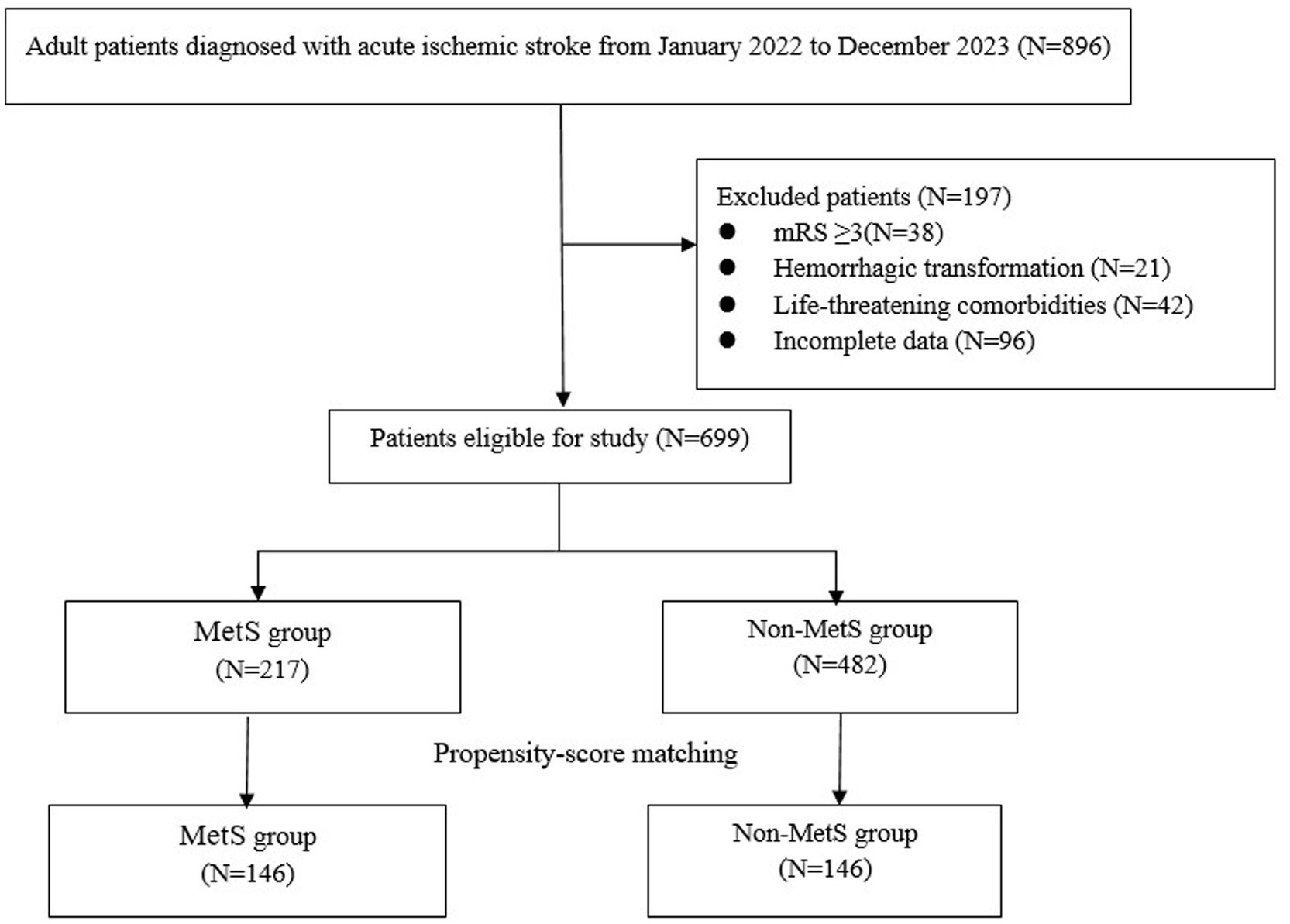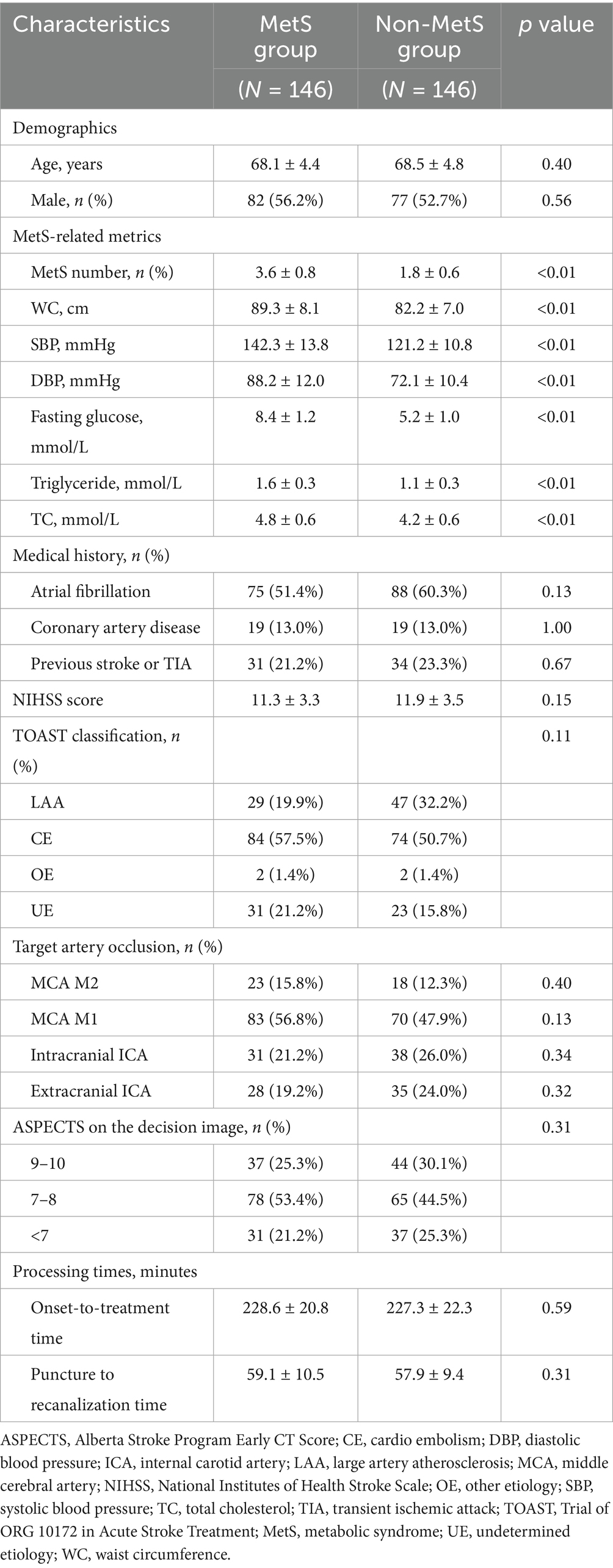- 1Department of Geriatric Medicine, Shanxi Bethune Hospital, Shanxi Academy of Medical Sciences, Third Hospital of Shanxi Medical University, Tongji Shanxi Hospital, Taiyuan, China
- 2Department of Neurology, Linfen People’s Hospital, Linfen, China
- 3Department of Neurology, Beijing Yanhua Hospital, Beijing, China
Objective: Metabolic syndrome (MetS) is a known risk factor for stroke, but its impact on prognosis after intravenous thrombolysis (IVT) in acute ischemic stroke (AIS) remains unclear. This study aimed to evaluate the association between MetS and prognosis in AIS patients treated with IVT.
Methods: We conducted a prospective cohort study including AIS patients who received IVT at Shanxi Bethune Hospital between January 2022 and December 2023. Propensity score matching (PSM) was applied to balance baseline characteristics between MetS and non-MetS groups. The primary outcome was 3-month all-cause mortality. Secondary outcomes included good functional outcome (modified Rankin Scale [mRS] 0–2) and symptomatic intracranial hemorrhage (SICH).
Results: After PSM, 292 patients (146 pairs) were enrolled in the analysis. The all-cause mortality rate within 3 months was significantly higher in the MetS group compared to the non-MetS group (24.0% vs. 11.6%; p < 0.01). Multivariate Cox regression analysis indicated that MetS was independently associated with increased 3-month mortality (adjusted hazard ratio [HR] = 2.50, 95% CI: 1.35–4.60; p < 0.01). A dose–response relationship was observed between the number of MetS components and mortality. Additionally, patients with MetS were less likely to achieve good functional outcomes (adjusted odds ratio [OR] = 0.47, 95% CI: 0.28–0.77; p < 0.01) and had a higher risk of SICH (adjusted OR = 2.40, 95% CI: 1.17–4.92; p = 0.02).
Conclusion: MetS is an independent predictor of increased mortality, poorer functional recovery, and higher risk of SICH in AIS patients treated with IVT. Early identification and management of metabolic risk factors may improve outcomes in this population.
Introduction
Acute ischemic stroke (AIS) is a leading cause of global morbidity and mortality worldwide, accounting for approximately 87% of all stroke cases (1). Despite advancements in reperfusion therapies—such as intravenous thrombolysis (IVT) with tissue plasminogen activator (tPA) and endovascular thrombectomy (EVT)—many stroke survivors experience persistent disability or death, underscoring the importance of identifying modifiable prognostic factors (2).
Metabolic syndrome (MetS), characterized by central obesity, hyperglycemia, dyslipidemia, and hypertension, is a recognized risk factor for cardiovascular disease (CVD) and stroke (3). Epidemiological studies show that MetS increases the risk of CVD by 2-fold and stroke by 1.5-fold (4). In recent years, research interest has extended beyond stroke prevention to its influence on post-stroke recovery. Mechanistically, MetS may impair neurological recovery after AIS by promoting systemic inflammation, endothelial dysfunction, and a prothrombotic state, all of which hinder neurovascular repair and exacerbate ischemic injury (5). However, findings on the relationship between MetS and stroke prognosis remain inconsistent. Some studies suggest that MetS independently predicts poorer outcomes and report a dose–response relationship between the number of MetS components and functional impairment (5). In contrast, other studies argue that the predictive value of MetS may primarily reflect the effect of its individual components rather than the syndrome as a whole (6). These discrepancies may be due to heterogeneity in patient populations, stroke subtypes, and treatment strategies across studies.
Among the currently approved therapies, IVT with tPA remains the cornerstone of acute reperfusion treatment for eligible AIS patients. As IVT-treated patients represent a more homogeneous group in terms of treatment protocol and timing, they provide a suitable population to assess the prognostic implications of MetS in a standardized clinical context. This study aimed to evaluate the association between MetS and prognosis in AIS patients receiving IVT.
Materials and methods
Patients
This prospective cohort study was conducted at Shanxi Bethune Hospital, a tertiary medical center, from January 2022 to December 2023. Consecutive patients aged ≥18 years who were admitted with a confirmed diagnosis of AIS by computed tomographic (CT) or magnetic resonance imaging (MRI) within 24 h of symptom onset were enrolled. Patients with a modified Rankin Scale (mRS) score ≥ 3 before stroke were excluded to minimize confounding from pre-existing disability, which could independently affect post-stroke outcomes. This criterion is consistent with prior studies that used similar cutoffs to ensure a more functionally homogeneous cohort (7, 8). Additional exclusion criteria included hemorrhagic transformation at admission, perioperative stroke (i.e., stroke occurring during or within 30 days of major surgery), life-threatening comorbidities (e.g., advanced malignancies), pregnancy, participation in other interventional clinical trials during the study period and incomplete clinical or follow-up data.
The study adhered to the ethical guidelines of the Declaration of Helsinki and was approved by the Ethics Committee of Shanxi Bethune Hospital (No. 20211033). Informed consent was provided by participants or legal representatives.
Definition of MetS
The MetS is a cluster of metabolic abnormalities and there are several definitions. In this study, we adopted the criteria proposed by the 2020 Chinese Diabetes Society (CDS) (9). The definition of MetS status requires the presence of any three or more of the following criteria: (1) abdominal obesity: waist circumference (WC) ≥ 90 cm in men or ≥85 cm in women; (2) hyperglycemia: fasting blood glucose (FBG) ≥ 6.1 mmol/L or 2-h postprandial glucose ≥7.8 mmol/L or previously diagnosed diabetes with treatment; (3) hypertension: systolic/diastolic blood pressure ≥130/85 mm Hg or currently under antihypertensive therapy; (4) triglycerides (TGs) ≥ 1.70 mmol/L; (5) high-density lipoprotein cholesterol (HDL-C) < 1.04 mmol/L. Patients were categorized into two groups based on the presence or absence of MetS.
Data collection and outcomes
Clinical data were extracted from electronic medical records, including patient’s demographics (age and sex), MetS-related metrics (WC, systolic blood pressure [SBP], diastolic blood pressure [DBP], fasting glucose, triglyceride, and total cholesterol [TC]), medical history (hypertension, atrial fibrillation, coronary artery disease, and previous stroke or transient ischemic attack), National Institutes of Health Stroke Scale (NIHSS), imaging data (trial of ORG 10,172 in Acute Stroke Treatment [TOAST] classification, target artery occlusion and Alberta Stroke Program Early Computed Tomography Score [ASPECTS]), and procedure-related characteristics (onset-to-treatment time and puncture to recanalization time). The baseline stroke severity was assessed by trained neurologists using the NIHSS. Ischemic stroke subtype was classified based on the TOAST classification. ASPECTS was used to evaluate the extent of preoperative early cerebral ischemia.
The primary outcome of this study was the rate of all-cause mortality within 3 months after enrollment. The secondary outcomes include the good functional outcome defined by a mRS of 0–2 at 3 months and the occurrence of symptomatic intracranial hemorrhage (SICH) within 3 months. Follow-up data were collected through medical records review or telephone interviews conducted by trained study coordinators who were blinded to the exposure status.
Statistical analysis
Continuous variables were tested for normality using the Shapiro–Wilk test. Normally distributed data were expressed as mean ± standard deviation (SD) and compared using Student’s t-test, while non-normally distributed data were presented as median (interquartile range, IQR) and compared using the Mann–Whitney U test. Categorical variables were expressed as frequencies (%) and compared using the chi-squared test or Fisher’s exact test, as appropriate.
To reduce the potential bias caused by baseline differences between MetS and non-MetS groups, propensity score matching (PSM) was performed. Propensity scores were calculated using a logistic regression model that included patient’s demographics, medical history, NIHSS score, imaging data, and procedure-related characteristics as covariates. Patients in the MetS group were matched 1:1 with those in the non-MetS group based on their propensity scores, using a nearest-neighbor matching algorithm without replacement and a caliper width of 0.2 of the standard deviation of the logit of the propensity score. Balance between the matched groups was assessed using standardized mean differences, with a threshold of <0.1 indicating adequate balance.
Based on an anticipated 12% difference in 3-month all-cause mortality between the MetS and non-MetS groups, we performed a post-hoc power analysis using the final matched sample size of 146 patients per group (total n = 292). Assuming a two-sided α level of 0.05, the calculated power exceeded 80%, indicating that the study was adequately powered to detect a statistically significant difference in mortality outcomes between the two groups.
Although PSM reduces baseline differences, we further applied multivariate regression analyses after matching to adjust for potential residual confounding and to enhance the precision of effect estimates, as recommended by prior studies (10). To evaluate the primary outcome, multivariate Cox proportional hazards regression analyses were used to assess the association between MetS and 3-month all-cause mortality, controlling for potential confounders including demographic characteristics, medical history, NIHSS, imaging findings, and procedure-related characteristics. In addition, multivariate logistic regression analyses were applied to evaluate the associations between MetS and secondary outcomes, including favorable functional outcome and SICH.
Statistical significance was defined as two-tailed p < 0.05. Statistical analysis was performed using the SPSS 22.0 for Windows (SPSS, IBM, United States).
Results
A total of 896 patients with AIS were initially enrolled in this study. After excluding 197 cases, the final analysis included 699 participants, among whom 217 (31.0%) were identified as having MetS. PSM yielded 146 matched pairs, resulting in 292 patients for subsequent comparisons (Figure 1). Baseline characteristics were well-balanced between the two groups, with no significant differences in age, sex, NIHSS score, TOAST classification, medical history, target artery occlusion, or processing times (all p > 0.05). However, significant differences were observed in several MetS-related parameters, including SBP, DBP, fasting glucose, triglyceride levels, and TC (all p < 0.01), consistent with the diagnostic criteria for MetS (Table 1).
Primary outcome: all-cause mortality
As shown in Figure 2, the 3-month all-cause mortality rate was significantly higher in the MetS group compared to the non-MetS group (24.0% vs. 11.6%; p < 0.01). Kaplan–Meier survival analysis (Figure 3A) showed that patients with MetS had a significantly higher risk of 30-day all-cause mortality compared to those without (HR = 2.18, 95% CI: 1.22–3.89; p < 0.01). After adjusting for potential confounders, MetS remained independently associated with increased mortality (HR = 2.50, 95% CI: 1.35–4.60; p < 0.01) (Table 2). Additionally, a dose–response relationship was observed between the number of MetS components and the all-cause mortality (Figure 3B). Compared to the patients with 1 MetS component, those with 2, 3, and 4–5 components were associated with 1.38-fold (95% CI: 0.75–2.06; p = 0.32), 2.49-fold (95% CI: 1.38–3.78; p < 0.01), and 3.27-fold (95% CI: 1.79–6.23; p < 0.01) increased risks of all-cause mortality.
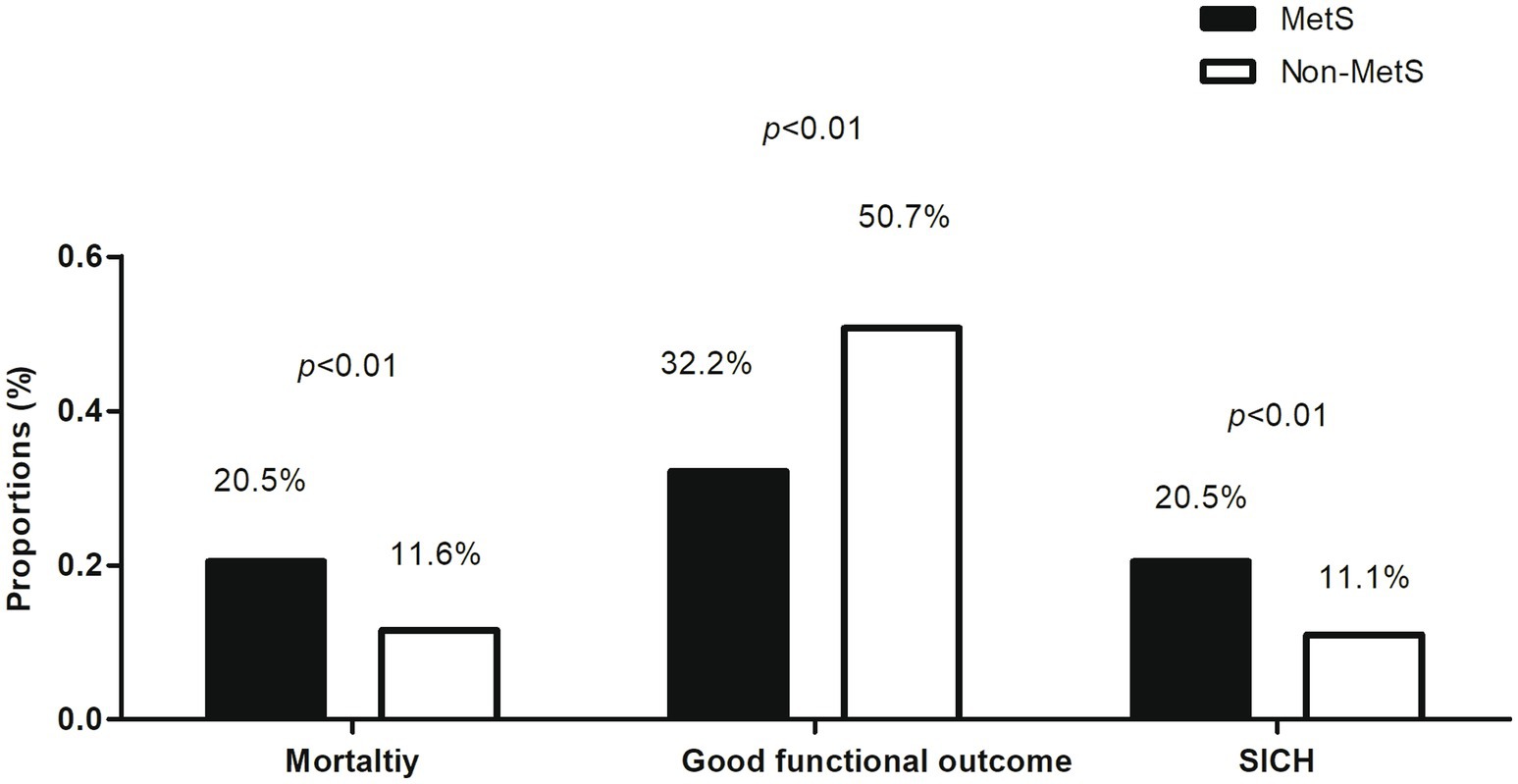
Figure 2. Comparison of the proportions of all-cause mortality, favorable functional outcomes, and symptomatic intracranial hemorrhage (SICH) between patients with and without metabolic syndrome (MetS).
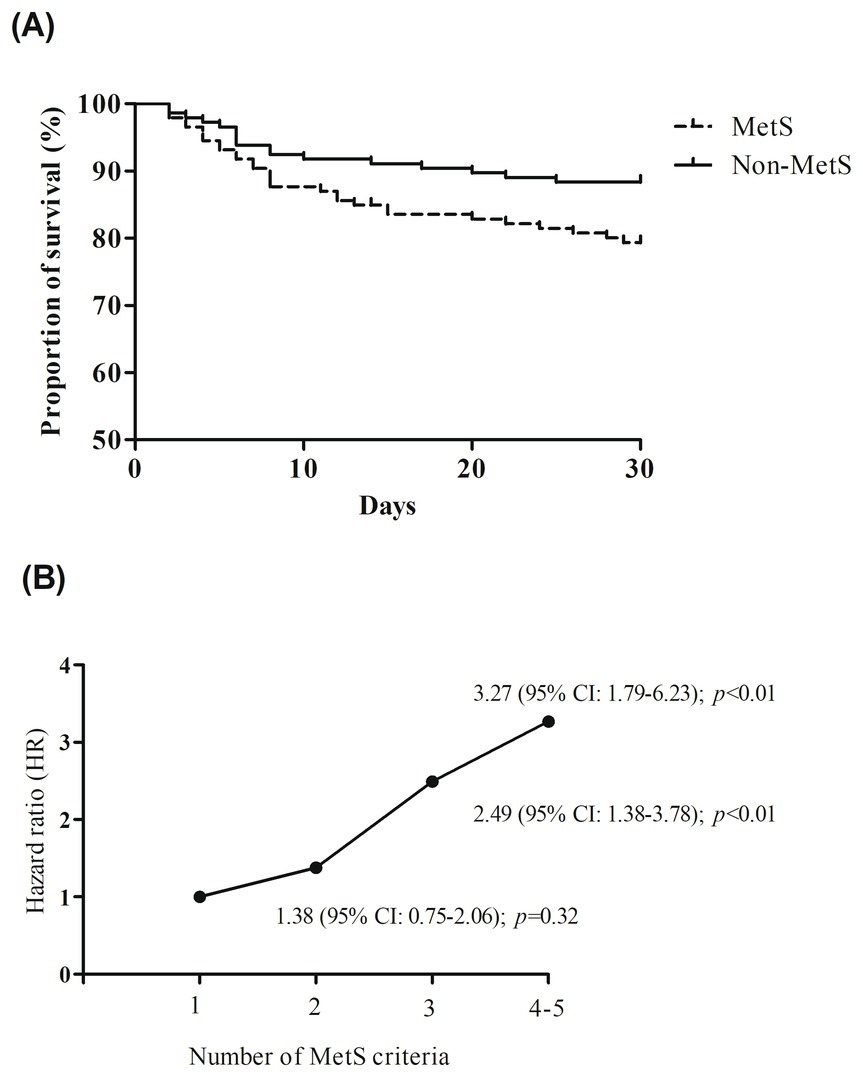
Figure 3. (A) Kaplan–Meier curves by the presence of metabolic syndrome (MetS) components. (B) The trend of effect-size estimates with the increasing number of MetS components.
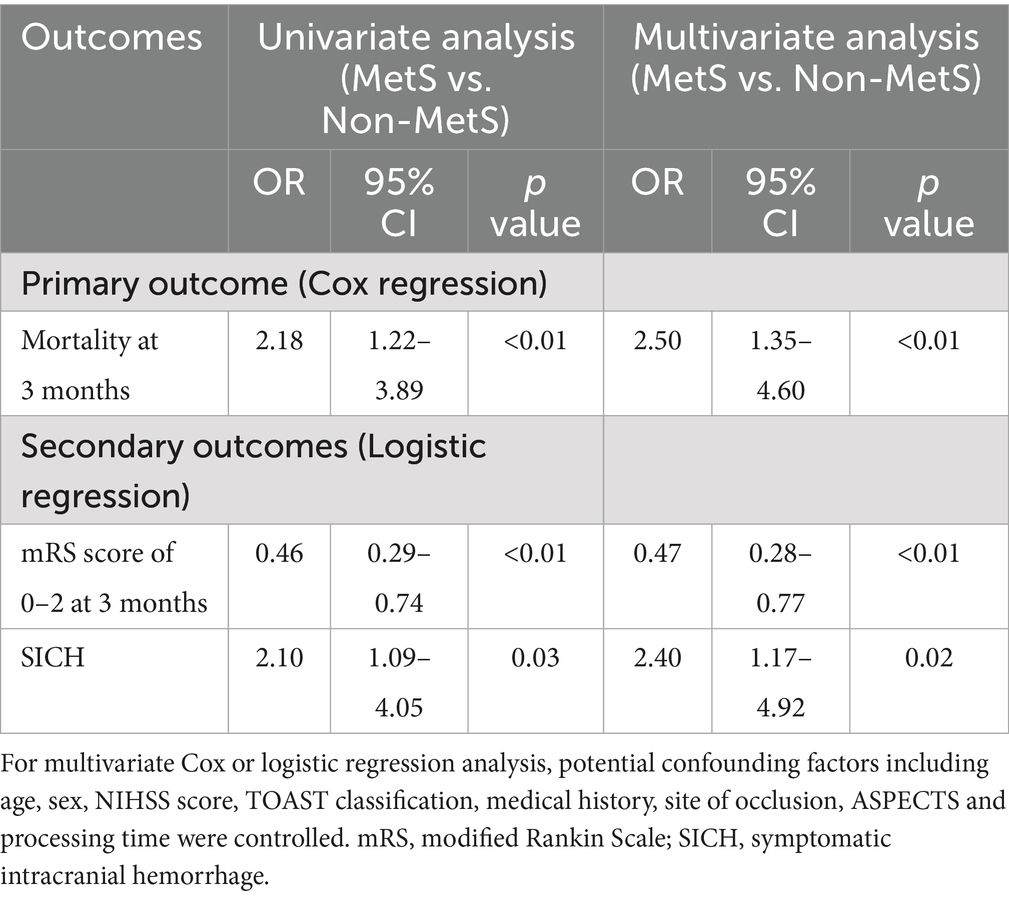
Table 2. Univariate and multivariate Cox and logistic regression analysis for primary and secondary outcomes.
Secondary outcomes
Patients in the MetS group were less likely to achieve a good functional outcome (mRS score of 0–2) at 3 months compared to the non-MetS group (32.2% vs. 50.7%; p < 0.01). This association persisted after multivariate adjustment (adjusted OR = 0.47, 95% CI: 0.28–0.77; p < 0.01).
The incidence of SICH within 3 months was significantly higher in the MetS group compared to the non-MetS group (20.5% vs. 11.0%; p < 0.01). After adjusting for confounders, MetS remained an independent predictor of SICH (adjusted OR = 2.40, 95% CI: 1.17–4.92; p = 0.02).
Discussion
In this prospective cohort study, we found that MetS was significantly associated with poor prognosis in patients with AIS after IVT. Specifically, patients with MetS exhibited higher all-cause mortality, lower rates of favorable functional outcomes (mRS 0–2), and an increased incidence of SICH at 3 months compared to those without MetS. These associations persisted after adjusting for potential confounders, suggesting that MetS is an independent predictor of adverse outcomes in this patient population.
The detrimental impact of MetS on stroke prognosis may be attributed to its multifaceted pathophysiological effects. Chronic low-grade inflammation and endothelial dysfunction, hallmarks of MetS, can impair neurovascular coupling and hinder neuronal repair processes (11, 12). Additionally, insulin resistance and hyperglycemia, key components of MetS, are known to increase oxidative stress, disrupt the blood–brain barrier, and impair cerebral autoregulation, which may exacerbate secondary brain injury after reperfusion therapies (13, 14). These mechanisms collectively contribute to worse neurological recovery, higher mortality, and increased hemorrhagic complications in patients with MetS.
Previous studies have reported inconsistent findings regarding the association between MetS and all-cause mortality. An observational study conducted by Suzuki et al. (15) indicated that MetS was significantly associated with increased mortality risk (HR = 1.26, 95% CI: 1.15–1.38). Similarly, the San Antonio Heart Study by Hunt et al. demonstrated a 1.47-fold (95% CI: 1.13–1.92) higher risk of all-cause mortality in individuals with MetS (16). In contrast, a study by Mi et al. (6) found no significant association between MetS and mortality. These discrepancies may be attributed to differences in cohort characteristics such as age, ethnicity, sex, treatment strategies, or other mortality risk factors. Our study strengthens the evidence linking MetS with increased mortality by using PSM to minimize selection bias and improve comparability between groups. Importantly, we identified a dose–response relationship between the number of MetS components and all-cause mortality risk, highlighting the cumulative impact of metabolic abnormalities on stroke outcomes. This finding underscores the importance of early identification and management of individual MetS components in AIS patients undergoing reperfusion therapies.
The reduced likelihood of favorable functional outcomes in patients with MetS underscores the need for early rehabilitation and tailored interventions to address metabolic disturbances in this population. In addition, our findings indicate a significantly increased risk of SICH among MetS patients receiving IVT. This result is consistent with previous studies suggesting that components of MetS—particularly hypertension, hyperglycemia, and dyslipidemia—may increase blood–brain barrier permeability and promote hemorrhagic transformation after thrombolysis (17, 18). For example, a study by Chen et al. reported a similar association between MetS and increased hemorrhagic complications following recanalization therapy for stroke (5). Conversely, other studies have found no significant relationship between MetS and SICH (19), possibly due to differences in patient characteristics, stroke subtypes, or baseline risk profiles. Taken together, our results contribute to the growing body of evidence emphasizing the importance for vigilant metabolic risk management—not only to improve functional recovery but also to reduce the incidence of serious complications such as SICH in AIS patients treated with IVT.
The strengths of our study include its prospective design, comprehensive data collection, and the application of PSM to control for baseline differences. However, several limitations should be noted. First, this was a single-center study, which may limit the generalizability of the findings. Second, although we adjusted for multiple confounding factors, residual confounding cannot be completely excluded. Third, we used the CDS criteria to define MetS, which may differ from other international definitions and affect comparisons with studies conducted in different regions. Future multicenter studies with larger cohorts and longer follow-up periods are warranted to validate our findings and explore targeted strategies to mitigate the adverse impact of MetS on stroke recovery.
In conclusion, MetS is independently associated with increased mortality, poor functional outcomes, and a higher risk of SICH in patients with AIS after IVT. These findings highlight the importance of comprehensive metabolic risk management to improve outcomes and reduce post-thrombolysis complications in this patient population.
Data availability statement
The raw data supporting the conclusions of this article will be made available by the authors, without undue reservation.
Ethics statement
The studies involving humans were approved by Ethics Committee of Shanxi Bethune Hospital. The studies were conducted in accordance with the local legislation and institutional requirements. The participants provided their written informed consent to participate in this study. Written informed consent was obtained from the individual(s) for the publication of any potentially identifiable images or data included in this article.
Author contributions
WC: Writing – original draft, Data curation, Conceptualization, Formal analysis. DL: Investigation, Writing – review & editing. ZL: Writing – review & editing, Investigation, Data curation. XZ: Conceptualization, Writing – review & editing, Supervision.
Funding
The author(s) declare that no financial support was received for the research and/or publication of this article.
Conflict of interest
The authors declare that the research was conducted in the absence of any commercial or financial relationships that could be construed as a potential conflict of interest.
Generative AI statement
The authors declare that no Gen AI was used in the creation of this manuscript.
Publisher’s note
All claims expressed in this article are solely those of the authors and do not necessarily represent those of their affiliated organizations, or those of the publisher, the editors and the reviewers. Any product that may be evaluated in this article, or claim that may be made by its manufacturer, is not guaranteed or endorsed by the publisher.
References
1. Li, J, Xiong, J, Chen, K, Sun, J, Fu, Q, and Yin, B. Comparison of magnetic resonance imaging versus computed tomography-based thrombolysis treatment in patients with acute ischemic stroke. J Clin Ultrasound. (2022) 50:176–81. doi: 10.1002/jcu.23126
2. Bae, JW, and Hyun, DK. Endovascular Thrombectomy for acute ischemic stroke: current concept in management. J Korean Neurosurg Soc. (2024) 67:397–410. doi: 10.3340/jkns.2023.0181
3. Neeland, IJ, Lim, S, Tchernof, A, et al. Metabolic syndrome. Nat Rev Dis Primers, (2024) 10:77. doi: 10.1038/s41572-024-00563-5
4. Bertoluci, MC, and Rocha, VZ. Cardiovascular risk assessment in patients with diabetes. Diabetol Metab Syndr. (2017) 9:25. doi: 10.1186/s13098-017-0225-1
5. Chen, Z, Su, M, Li, Z, du, H, Zhang, S, Pu, M, et al. Metabolic syndrome predicts poor outcome in acute ischemic stroke patients after endovascular Thrombectomy. Neuropsychiatr Dis Treat. (2020) 16:2045–52. doi: 10.2147/NDT.S264300
6. Mi, D, Zhang, L, Wang, C, Liu, L, Pu, Y, Zhao, X, et al. Impact of metabolic syndrome on the prognosis of ischemic stroke secondary to symptomatic intracranial atherosclerosis in Chinese patients. PLoS One. (2012) 7:e51421. doi: 10.1371/journal.pone.0051421
7. Albers, GW, Marks, MP, Kemp, S, Christensen, S, Tsai, JP, Ortega-Gutierrez, S, et al. Thrombectomy for stroke at 6 to 16 hours with selection by perfusion imaging. N Engl J Med. (2018) 378:708–18. doi: 10.1056/NEJMoa1713973
8. de Havenon, A, Castonguay, A, Nogueira, R, Nguyen, TN, English, J, Satti, SR, et al. Prestroke disability and outcome after Thrombectomy for emergent anterior circulation large vessel occlusion stroke. Neurology. (2021) 97:e1914–9. doi: 10.1212/WNL.0000000000012827
9. Shi, G, Zhu, N, Qiu, L, Yan, H, Zeng, L, Wang, D, et al. Impact of the 2020 China diabetes society guideline on the prevalence of diabetes mellitus and eligibility for antidiabetic treatment in China. Int J Gen Med. (2021) 14:6639–45. doi: 10.2147/IJGM.S331948
10. Fan, B, Ren, K, and Li, L. Propensity score matching analysis of the association between physical activity and multimorbidity in middle-aged and elderly Chinese. Sci Rep. (2024) 14:31166. doi: 10.1038/s41598-024-82335-5
11. Aboonabi, A, Meyer, RR, and Singh, I. The association between metabolic syndrome components and the development of atherosclerosis. J Hum Hypertens. (2019) 33:844–55. doi: 10.1038/s41371-019-0273-0
12. Zhang, H, and Dhalla, NS. The role of pro-inflammatory cytokines in the pathogenesis of cardiovascular disease. Int J Mol Sci. (2024) 25:1082. doi: 10.3390/ijms25021082
13. Monserrat-Mesquida, M, Quetglas-Llabres, M, Capo, X, Bouzas, C, Mateos, D, Pons, A, et al. Metabolic syndrome is associated with oxidative stress and proinflammatory state. Antioxidants. (2020) 9:236. doi: 10.3390/antiox9030236
14. Ding, PF, Zhang, HS, Wang, J, Gao, YY, Mao, JN, Hang, CH, et al. Insulin resistance in ischemic stroke: mechanisms and therapeutic approaches. Front Endocrinol. (2022) 13:1092431. doi: 10.3389/fendo.2022.1092431
15. Suzuki, T, Voeks, J, Zakai, NA, Jenny, NS, Brown, TM, Safford, MM, et al. Metabolic syndrome, C-reactive protein, and mortality in U.S. blacks and whites: the reasons for geographic and racial differences in stroke (REGARDS) study. Diabetes Care. (2014) 37:2284–90. doi: 10.2337/dc13-2059
16. Hunt, KJ, Resendez, RG, Williams, K, Haffner, SM, and Stern, MPSan Antonio Heart S. National cholesterol education program versus World Health Organization metabolic syndrome in relation to all-cause and cardiovascular mortality in the San Antonio heart study. Circulation. (2004) 110:1251–7. doi: 10.1161/01.CIR.0000140762.04598.F9
17. Hafez, S, Coucha, M, Bruno, A, Fagan, SC, and Ergul, A. Hyperglycemia, acute ischemic stroke, and thrombolytic therapy. Transl Stroke Res. (2014) 5:442–53. doi: 10.1007/s12975-014-0336-z
18. Colombari, E, Biancardi, VC, Colombari, DSA, Katayama, PL, Medeiros, FC, Aitken, AV, et al. Hypertension, blood-brain barrier disruption and changes in intracranial pressure. J Physiol. (2025) 603:2245–61. doi: 10.1113/JP285058
19. Sobolewski, P, Brola, W, Szczuchniak, W, Fudala, M, and Kozera, G. Intravenous thrombolysis with recombinant tissue-type plasminogen activator for acute ischemic stroke in patients with metabolic syndrome. J Stroke Cerebrovasc Dis. (2015) 24:1787–92. doi: 10.1016/j.jstrokecerebrovasdis.2015.04.001
Keywords: acute ischemic stroke, intravenous thrombolysis, prognosis, metabolic syndrome, mortality
Citation: Chen W, Liu D, Li Z and Zhang X (2025) Metabolic syndrome is associated with prognosis in patients with acute ischemic stroke after intravenous thrombolysis: a prospective cohort study. Front. Neurol. 16:1598434. doi: 10.3389/fneur.2025.1598434
Edited by:
Fulvio Tartara, University Hospital of Parma, ItalyReviewed by:
Xiaojia Ni, Guangzhou University of Traditional Chinese Medicine, ChinaHang Ruan, Huazhong University of Science and Technology, China
Copyright © 2025 Chen, Liu, Li and Zhang. This is an open-access article distributed under the terms of the Creative Commons Attribution License (CC BY). The use, distribution or reproduction in other forums is permitted, provided the original author(s) and the copyright owner(s) are credited and that the original publication in this journal is cited, in accordance with accepted academic practice. No use, distribution or reproduction is permitted which does not comply with these terms.
*Correspondence: Xiaofang Zhang, emhhbmd4aWFvZmFuZ2JqeWhAMTYzLmNvbQ==
 Wenyan Chen
Wenyan Chen Dandan Liu
Dandan Liu Zhiqiang Li
Zhiqiang Li Xiaofang Zhang
Xiaofang Zhang